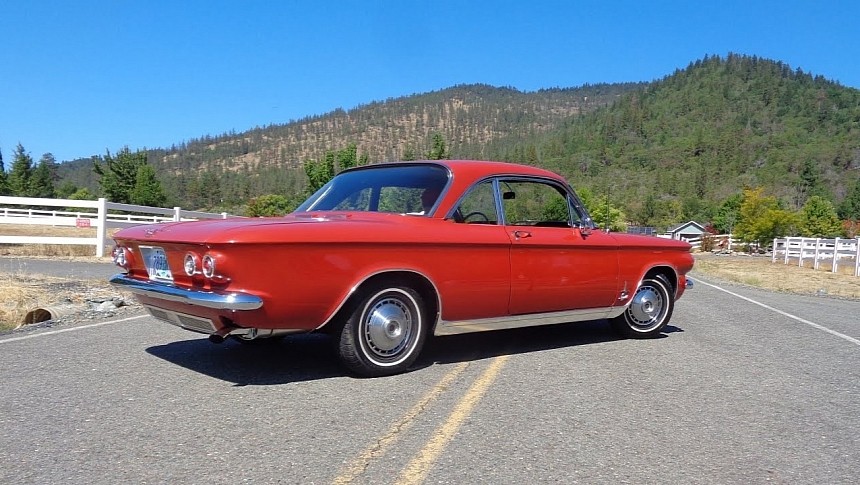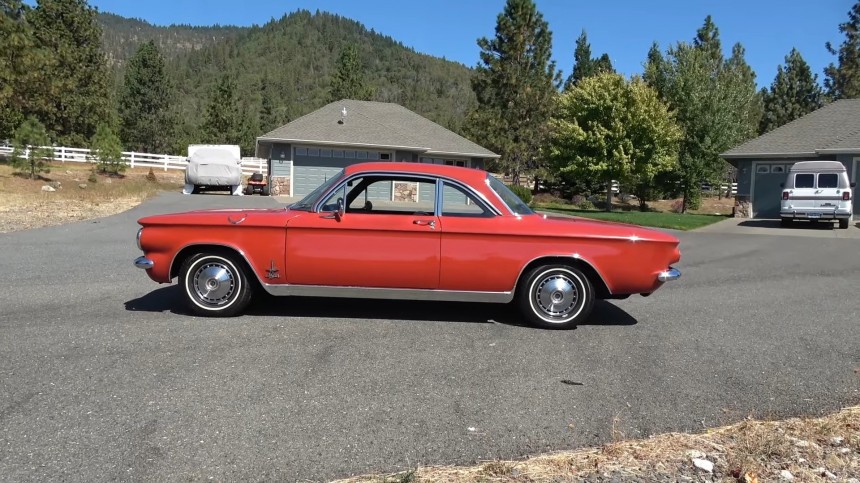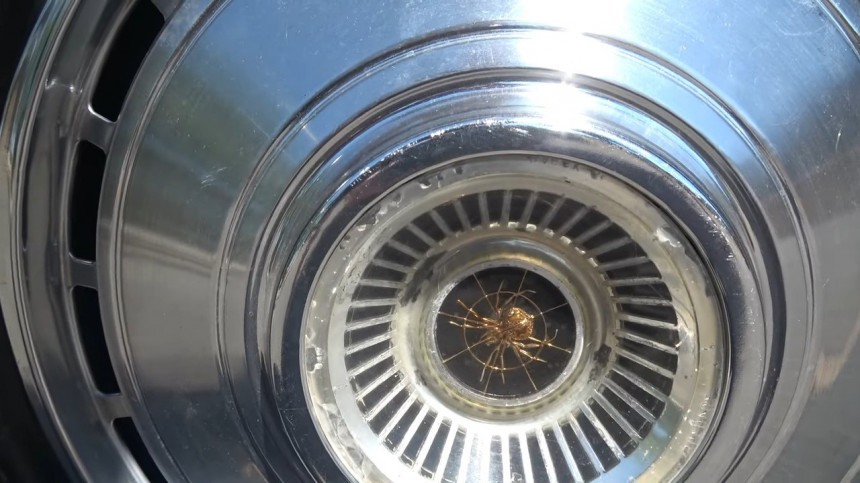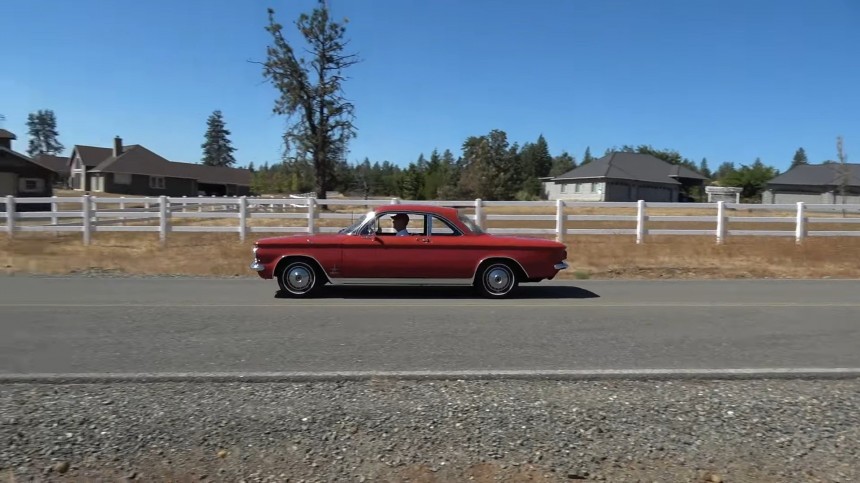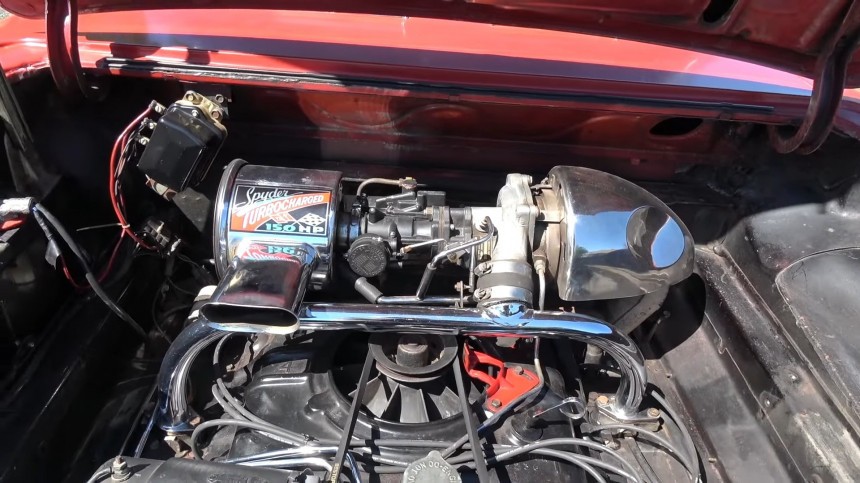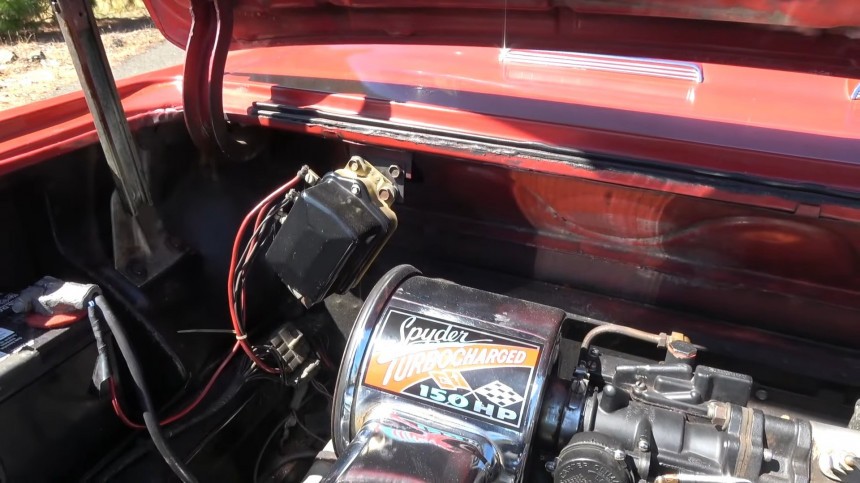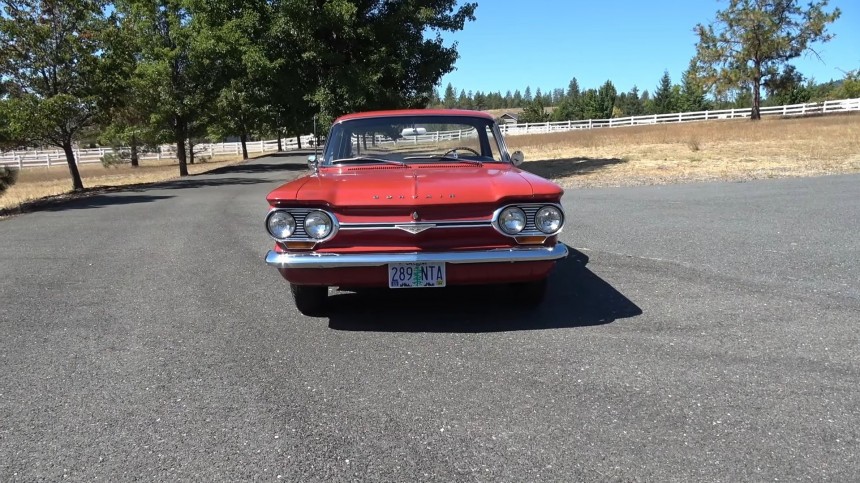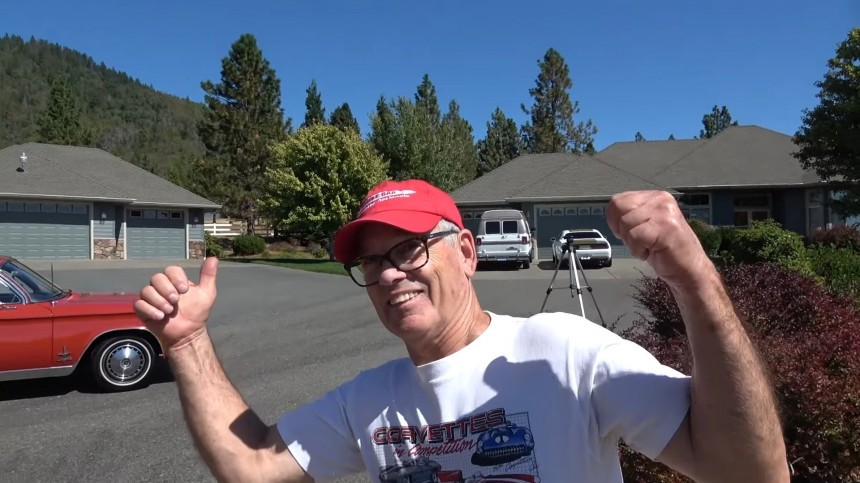History is funny sometimes - it has a wicked sense of humor, which occasionally rolls over several generations before being fully understood and appreciated. The Chevrolet Corvair is – or instead was – the victim of a practical joke of cosmic proportions, being the scapegoat of a scandal that expanded like the chaos theory. Regardless of how the universe decided to play its cards against an American automotive symbol, the Corvair remains an exciting car to this day – perhaps owing a significant portion of its popularity to the exact cause of its demise.
The Corvair was the American response to the German RR-designed platforms from Porsche and Volkswagen. The rear-mounted air-cooled engine and transaxle that GM proposed in January 1960 was a success – from a sales standpoint – with a quarter of a million odd Chevys roaming free on America’s fresh highways.
The unusual little car did even better in 1961, again leaping over the 250,000-unit mark by a 32,000-car margin and recording its best money-pocketing performance in 1962, with over 292,000 Corvairs. During its ten-year production (1960-1969), the non-mainstream Chevrolet averaged 140,000 cars produced for the U.S. market alone.
There are two main categories of the quirky Corvair: the EM – Early Model – from its beginning until the end of the 1964 model year, and the LM – Late Model – from 1965 onward. There’s a common popular belief – controversial and debatable, to say the least – that the downfall of the rear-engined American-made automobile was an inside job.
Allow me to elaborate on the matter: in November 1965, a book called ‘Unsafe at Any Speed: The Designed-In Dangers of the American Automobile’ written by a fellow by the name of Ralph Nader, machine-gunned the auto industry for its resistance to adopt safety measures for the car occupants.
Unfortunately, the first chapter – titled ‘The Sporty Corvair’ – axed the car’s alleged unsafe handling caused by the rear swing-axles fitted to the 1960-64 models. The book's appearance – which became a non-fictional best-seller in 1966 – coincided with an abyssal drop in the Corvair’s sales.
From an average of over 250,000 cars sold in the first six model years between 1960 and 1965, the Chevrolet model rolled just under 104,000 in 1966. The two events were put together in a cause-and-effect relationship. But there is a crack in the shell of this logic argument – consisting of two factors.
First, the Corvair had already ditched its tuck-under-prone suspension system beginning with the 1964 model, switching to double-jointed drive axles instead of the trigger-happy swing-axles. By comparison, Volkswagen’s Beetle didn't get rid of theirs until 1969 – and I’ve dropped the German reference because the Corvair was aimed at them.
But the straw that broke the Corvair’s rear-engined back came not from a book (written by a man who hadn’t driven one) but from across the road in Detroit. Namely, 1964 was the year of the wonder-kid car of the sixties – the pony car. Ford’s Mustang broke the bank with its sales performance, and the Corvair suddenly fell on the wrong side of the love affair between the American buyer and the domestic carmaking industry.
Ironically, if anything, the book actually prolonged the agonizing life of the Chevrolet model by three years. Not wanting to appear to knuckle under Nader’s unsubstantiated allegations, GM kept the Corvair in production after 1966, despite the corporation retaliating against the Mustang with their own pony – the Camaro.
The Corvair and the Camaro were fighting for the same public segment. Still, the more conventional platform of the former had much greater appeal to the front-engined-minded citizens of the United States of Automobile. The Corvair didn’t die out because of a book – General Motors restored its fame in 1972 when the National Highway Traffic Safety Administration debunked the bad handling myth with a thorough investigation that concluded in the Corvair’s favor.
According to the research that tested a 1963 model, the car didn’t perform any worse than other contemporary automobiles of the same model year, both foreign and domestic. To add to the twisted humor of this already mind-blowing situation, the NHTSA was created as a direct consequence of Ralph Nader’s book (and so was the Department of Transportation, if you’re curious).
To back the federal decision, here is a 1964 Chevrolet Corvair going strong six decades after its rear-mounted engine first fired up. Its owner is more than satisfied with the car’s road stance – partly due to the spider mascot on the hubcaps. What does an engraving have to do with a car’s road tenure? The answer lies under the engine bay lid.
It sounds strange to say the motor is not under the hood, but that’s one of the Corvair’s distinctive features. Among the many variants of the Corvair, one particular iteration has a special place in the hearts of the fans: the Monza Spyder.
The Spyder designation is not related to the body style (like it would imply in ‘’regular cars) being a convertible, but it is directly related to an engine attribute: a turbocharger. Introduced for the 1962 model and kept in production until the end of 1966, the free-horsepower-making exhaust-gases-driven compressor made all the difference in the world.
The horizontally-opposed six-cylinder air-cooled engine installed in the first Corvair was a 140-cube (2.3 liters), 80-hp naturally-aspirated unit that didn’t impress at all. However, by 1964, the displacement had grown, first to 145 CID (2.4 liters) and then to 164 CID (2.7 liters). Add a turbo to the intake of this former unit, and suddenly, 150 horses are galloping down the road.
That is what the Spyders got – the hot turbo engine (although Chevrolet did call its powerplants Turbo Air, not all had a compressor strapped at the induction end). Power-wise, the compact aluminum engine wasn’t exactly on par with its cast iron rivals, occupying nearly three times more volume in the engine bays. Still, it wasn’t a slug, either.
Car Life magazine tested a pair of Corvairs in the summer of 1962. The automatic-equipped Monza Coupe with the 84-horsepower engine scored a measly 0-60 mph (97 kph) time of 21.6 seconds and a top speed of 90 mph (145 kph).
Fitted with a four-speed manual transmission, the 150-horsepower turbocharged Corvair Monza halved the acceleration time to 10.8 seconds and peaked at 105 mph (170 kph). The journalists noted that the turbo completely changed the car's character, putting “this compact into a class by itself."
It didn’t do much to the Corvair’s fate, though – the arrival of the Mustang adversary and the Camaro comeback from Chevrolet sealed the deal. However, the Nader scandal prolonged the life of the odd-bird Chevrolet. The Corvair stayed around for three extra years because GM didn’t want to look like it acknowledged the car’s unjustified drawbacks. Initially, GM planned to sack the model when the Camaro was launched in the fall of 1966.
Even though it performed satisfactorily in the sales charts, it didn’t generate enough showroom traffic to justify its production, and the bosses at General Motors voted to kill the Corvair before the Ralph Nader incident.
The car featured in the video below is a 1964 turbo Monza model – as indicated by the Spyder callouts and the spiders on the hubcaps – and its owner claims the car is original. This red-on-black Monza spent its life in SoCal, which explains the rust-free condition.
The current owner purchased it last year when it was advertised for sale for a very attractive $16,000. Not bad at all for a 31,000-mile (around 50,000 km) car believed to be all original, from bumper to bumper. The current owner, seen counting smiles per gallon behind the wheel of the Corvair, added only 720 miles (around 1,100 kilometers) in the last 12 months and plans to give the car a modernization, but only to improve comfort and safety, without sacrificing looks or the car’s spirit.
A keen eye might argue that the paint job isn’t GM-issue standard since the factory paint didn’t have the rough texture of this Corvair’s livery. However, six decades of exposure to various elements, even in the merciful climate of Southern California, take a toll. This Corvair is still a stunner even with this Earl Scheib "Diamond Gloss" paint job look.
The unusual little car did even better in 1961, again leaping over the 250,000-unit mark by a 32,000-car margin and recording its best money-pocketing performance in 1962, with over 292,000 Corvairs. During its ten-year production (1960-1969), the non-mainstream Chevrolet averaged 140,000 cars produced for the U.S. market alone.
There are two main categories of the quirky Corvair: the EM – Early Model – from its beginning until the end of the 1964 model year, and the LM – Late Model – from 1965 onward. There’s a common popular belief – controversial and debatable, to say the least – that the downfall of the rear-engined American-made automobile was an inside job.
Unfortunately, the first chapter – titled ‘The Sporty Corvair’ – axed the car’s alleged unsafe handling caused by the rear swing-axles fitted to the 1960-64 models. The book's appearance – which became a non-fictional best-seller in 1966 – coincided with an abyssal drop in the Corvair’s sales.
From an average of over 250,000 cars sold in the first six model years between 1960 and 1965, the Chevrolet model rolled just under 104,000 in 1966. The two events were put together in a cause-and-effect relationship. But there is a crack in the shell of this logic argument – consisting of two factors.
But the straw that broke the Corvair’s rear-engined back came not from a book (written by a man who hadn’t driven one) but from across the road in Detroit. Namely, 1964 was the year of the wonder-kid car of the sixties – the pony car. Ford’s Mustang broke the bank with its sales performance, and the Corvair suddenly fell on the wrong side of the love affair between the American buyer and the domestic carmaking industry.
Ironically, if anything, the book actually prolonged the agonizing life of the Chevrolet model by three years. Not wanting to appear to knuckle under Nader’s unsubstantiated allegations, GM kept the Corvair in production after 1966, despite the corporation retaliating against the Mustang with their own pony – the Camaro.
According to the research that tested a 1963 model, the car didn’t perform any worse than other contemporary automobiles of the same model year, both foreign and domestic. To add to the twisted humor of this already mind-blowing situation, the NHTSA was created as a direct consequence of Ralph Nader’s book (and so was the Department of Transportation, if you’re curious).
To back the federal decision, here is a 1964 Chevrolet Corvair going strong six decades after its rear-mounted engine first fired up. Its owner is more than satisfied with the car’s road stance – partly due to the spider mascot on the hubcaps. What does an engraving have to do with a car’s road tenure? The answer lies under the engine bay lid.
The Spyder designation is not related to the body style (like it would imply in ‘’regular cars) being a convertible, but it is directly related to an engine attribute: a turbocharger. Introduced for the 1962 model and kept in production until the end of 1966, the free-horsepower-making exhaust-gases-driven compressor made all the difference in the world.
The horizontally-opposed six-cylinder air-cooled engine installed in the first Corvair was a 140-cube (2.3 liters), 80-hp naturally-aspirated unit that didn’t impress at all. However, by 1964, the displacement had grown, first to 145 CID (2.4 liters) and then to 164 CID (2.7 liters). Add a turbo to the intake of this former unit, and suddenly, 150 horses are galloping down the road.
Car Life magazine tested a pair of Corvairs in the summer of 1962. The automatic-equipped Monza Coupe with the 84-horsepower engine scored a measly 0-60 mph (97 kph) time of 21.6 seconds and a top speed of 90 mph (145 kph).
Fitted with a four-speed manual transmission, the 150-horsepower turbocharged Corvair Monza halved the acceleration time to 10.8 seconds and peaked at 105 mph (170 kph). The journalists noted that the turbo completely changed the car's character, putting “this compact into a class by itself."
Even though it performed satisfactorily in the sales charts, it didn’t generate enough showroom traffic to justify its production, and the bosses at General Motors voted to kill the Corvair before the Ralph Nader incident.
The car featured in the video below is a 1964 turbo Monza model – as indicated by the Spyder callouts and the spiders on the hubcaps – and its owner claims the car is original. This red-on-black Monza spent its life in SoCal, which explains the rust-free condition.
A keen eye might argue that the paint job isn’t GM-issue standard since the factory paint didn’t have the rough texture of this Corvair’s livery. However, six decades of exposure to various elements, even in the merciful climate of Southern California, take a toll. This Corvair is still a stunner even with this Earl Scheib "Diamond Gloss" paint job look.
